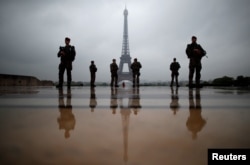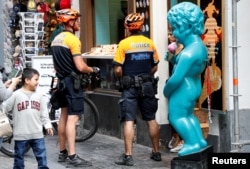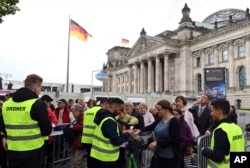Summertime in Europe often means that large-scale outdoor events are planned for weeks in a row, with lots of people in public spaces. But vehicles have been used several times to kill and wound pedestrians and citizens since last year’s attack in Nice, France. Vans and cars have also been used to carry out attacks in Germany, Sweden and Britain.
European cities are known for their open public spaces, but more measures have been implemented to keep citizens safer.
Adjusting to this reality means cities are adopting several approaches to protect their citizens without turning their open cities into heavily-secured forts. An example of this is the dozens of flowerpots on a large pedestrian street in the city of Brussels, which are actually cement blocks in disguise.
Belgian Crisis Center Spokesman Peter Mertens says that more than a year after the March 2016 Brussels attacks, the threat level is still at 3 out of 4.
“Places where people come together are a potential target and we need to be aware of that. We are taking traffic obstructive measures, such as cement blocks. Local governments are incorporating them into public spaces by building flowerpots around the blocks so that it is visually less confronting for people but can still be effective.”
Belgian military troops are still patrolling the streets of the capital city. Brussels was the scene of bombings in March 2015 at the airport and a metro station, and several terrorists of the Paris attacks in 2015 were linked to Brussels.
Attacks where a vehicle drives into the public are difficult to prevent, as the attackers are often working alone, although Islamic State has taken credit for some of the attacks.
Thomas Renard, a senior research fellow at the Belgian Egmont Institute, says that despite most measures taken by cities being reactive, it doesn’t mean another attack can be prevented.
“Trucks and cars have been used before, but not to the same extent. In the past few weeks, notably in the Westminster attack in London, we see that the attackers can also show a lack of originality. So they copy and reuse the technique over and over again," said Renard. "Even though we could say that very often measures are reactive, there is also certain logic because also the attackers also tend to reuse techniques.”
Summer means many outdoor activities that draw large crowds. In Berlin, where a truck killed 12 people and wounded 56 at a Christmas market in December, large-scale events are handled differently now.
Events that have taken place this month in Berlin were fenced off, large backpacks were no longer allowed, and there was more police presence. There was live video surveillance and concrete blocks lined the sidewalks for the duration of an event.
Interior Senator Andreas Geisel's spokesman, Martin Pallgen, says European cities are more aware than before.
“Nobody knows what will happen next. There are security concepts and security measures made before an event to see what is possible before and absolutely necessary during events and what can you do after the events. The Manchester [UK]) attack took place after the concert. All these small things that change the point of security view we have on this. Nobody can really guarantee 100 percent security for a free society.”
European cities that haven’t been attacked, such as the Dutch capital of Amsterdam, keep an eye out for developments and events in cities across Europe. The office of the mayor says, “recent attacks abroad fit in to the current threat analysis and underscore the reality of what big cities in Europe are dealing with at the moment.”
When several people were hurt by a car in the city of Amsterdam last weekend, there were immediate fears of a terrorist attack. Police concluded the driver did not intentionally drive into people, but had health issues.




